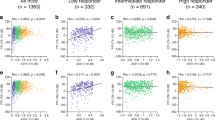Abstract
An increase in general responsiveness after aversive stimulation has provided a most widely accepted and well-understood sensitization paradigm. According to a second paradigm (based on the dual process theory of habituation and sensitization), not only additional aversive stimuli, but also the response-eliciting stimuli themselves, induce sensitization. To relate these two sensitization paradigms, we compared the course of startle response parameters during repetitive acoustic stimulation with the change in startle amplitude after electric footshocks in outbred Wistar and Sprague–Dawley rats. Compared to the Wistar rats used, the Sprague–Dawley rats showed a lower response decrement and a shortened latency during repetitive stimulation, both of which are indicators of increased sensitization by the startle-eliciting stimuli. In addition, the Sprague–Dawley rats also demonstrated a reduced increase in startle amplitude following footshock. This was postulated to be a consequence of the strong sensitization by startle-eliciting stimuli, which interferes with sensitization elicited by footshock. Because our Wistar and Sprague–Dawley rats did not differ in initial startle amplitude, but mainly in susceptibility to sensitization, further comparisons of these genetically different stocks of rats seem to be of potential value in studying differences in fear-motivated behavior.
Similar content being viewed by others
REFERENCES
Abel, E. L. (1992). Response to alarm substance in different rat strains. Physiol. Behav. 51:345–347.
Acri, J. B., Brown, K. J., Saah, J. I., and Grunberg, N. E. (1995). Strain and age differences in acoustic startle responses and effects of nicotine in rats. Pharmacol. Biochem, Behav. 50:191–198.
Borszcz, G. S., Cranney, J., and Leaton, R. N. (1989). Influence of long-term sensitization on long-term habituation of the acoustic startle response in rats: Central gray lesions, preexposure, and extinction. J. Exp. Psychol. Anim. Behav. Proc. 15:54–64.
Commissaris, R. L., Harrington, G. M., Ortiz, A. M., and Altman, H. J. (1986). Maudsley Reactive and Non-reactive rat strains: Differential performance on a conflict task. Physiol. Behav. 38:291–294.
Commissaris, R. L., Harrington, G. M., Baginski, T. J., and Altman, H. J. (1988). MR/Har and MNRA/Har Maudsley rat strains: Differences in acoustic startle habituation. Behav. Genet. 18:663–669.
Davis, M. (1989). Sensitization of the acoustic startle reflex by footshock. Behav. Neurosci. 103:495–503.
Davis, M., Falls, W. A., Campeau, S., and Kim, M. (1993). Fearpotentiated startle: A neural and pharmacological analysis. Behav. Brain Res. 58:175–198.
Glowa, J. R., and Hansen, C. T. (1994). Differences in response to an acoustic startle stimulus among forty-six rat strains. Behav. Genet. 24:79–84.
Grasing, K., Wang, A., and Schlussman, S. (1996). Behavioral measures of anxiety during opiate withdrawal. Behav. Brain Res. 80:195–201.
Groves, P. M., and Thompson, R. F. (1970). Habituation: A dual process theory. Psychol. Rev. 77:419–450.
Iso, H., Brush, F. R., Fujii, M., and Shimazaki, M. (1988). Runningwheel avoidance learning in rats (rattus norvegicus): Effects of contingencies and comparisons of different strains. J. Comp. Psychol. 102:350–371.
Landis, C., and Hunt, W. A. (1939). The Startle Pattern, Farrar and Rinehart, New York.
Lee, Y., Lopez, D. E., Meloni, E. G., and Davis, M. (1996). A primary acoustic startle pathway: Obligatory role of cochlear root neurons and the nucleus reticularis pontis caudalis. J. Neurosci. 16:3775–3789.
Pilz, P. K. D, and Schnitzler, H.-U. (1996). Habituation and sensitization of the acoustic startle response in rats: Amplitude, threshold, and latency measures. Neurobiol. Learn. Mem. 66:67–79.
Pinsker, H., Kupfermann, I., Castellucci, V., and Kandel, E. (1970). Habituation and Dishabituation of the gill-withdrawal reflex in Aplysia. Science 167:1740–1742.
Plappert, C. F., Pilz, P. K. D., and Schnitzler, H.-U. (1999). Interaction between acoustic and electric sensitization of the acoustic startle responce in rat. Behav. Brain Res.: in press.
Rigdon, G. C. (1990). Differential effects of apomorphine on prepulse inhibition of acoustic startle reflex in two rat strains. Psychopharmacology 102:419–421.
Rinaldi, P. C., and Thompson, R. F. (1985). Age, sex and strain comparison of habituation of the startle response in the rat. Physiol. Behav. 35:9–13.
Schwegler, H., Pilz, P. K. D., Koch, M., Fendt, M., Linke, R., and Driscoll, P. (1997). The acoustic startle response in inbred roman high-and low-avoidance rats. Behav. Genet. 27:579–582.
Wilkinson, L. (1996). Systat: Statistics, SPSS Inc., Chicago.
Yeomans, J. S., and Frankland, P. W. (1996). The acoustic startle reflex: neurons and connections. Brain. Res. Rev. 21:301–314.
Author information
Authors and Affiliations
Rights and permissions
About this article
Cite this article
Pilz, P.K.D., Linke, R., Yilmazer-Hanke, D.M. et al. Comparison of Two Sensitization Paradigms of the Acoustic Startle Response in Wistar and Sprague–Dawley Rats. Behav Genet 29, 59–63 (1999). https://doi.org/10.1023/A:1021442006821
Issue Date:
DOI: https://doi.org/10.1023/A:1021442006821




